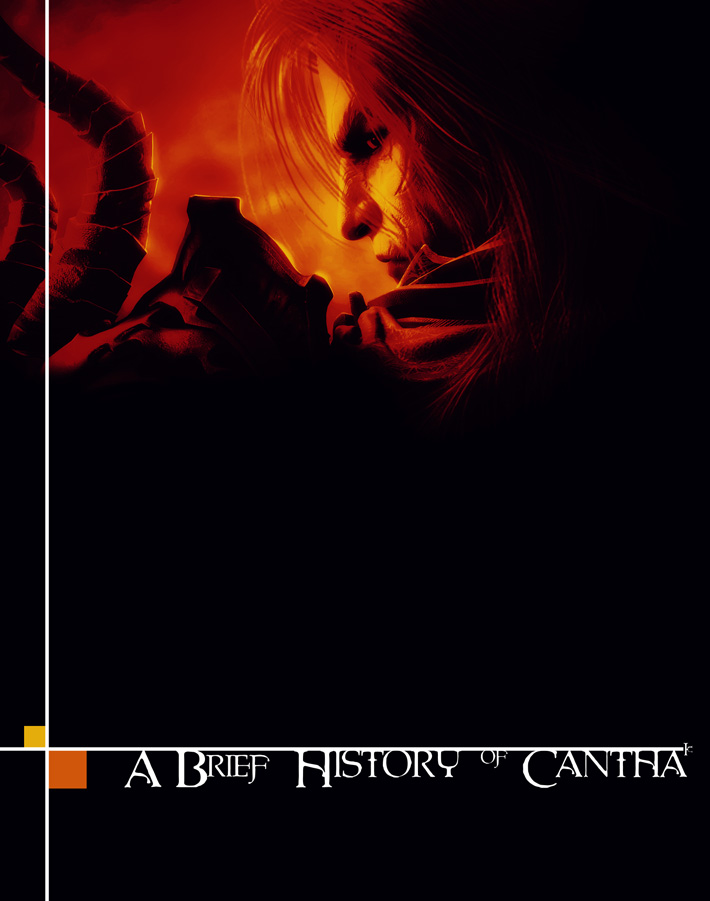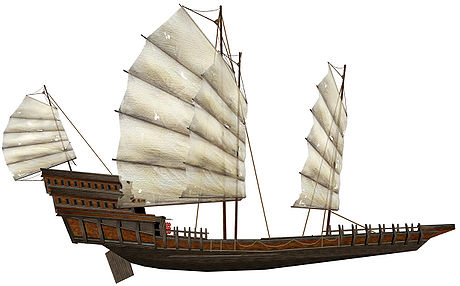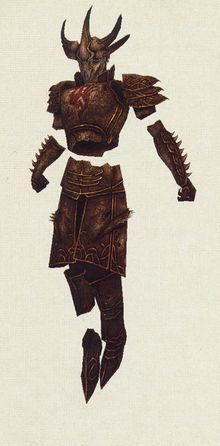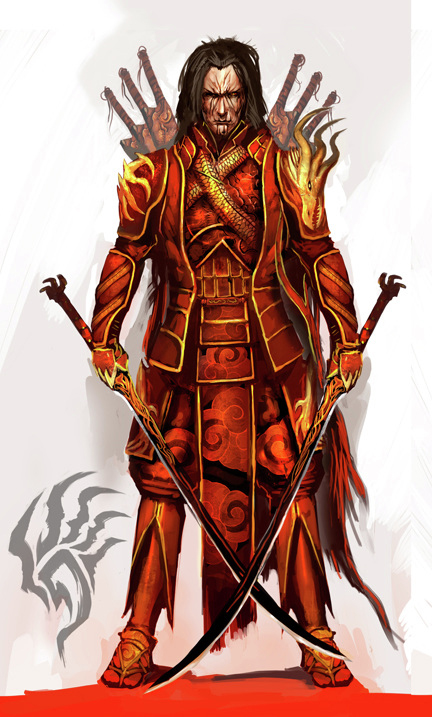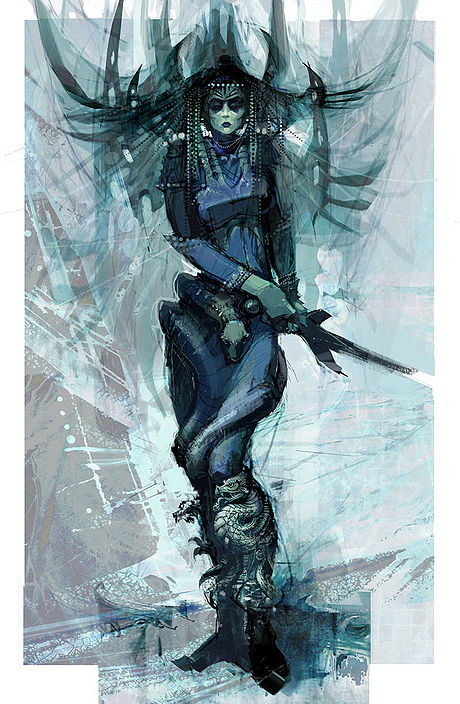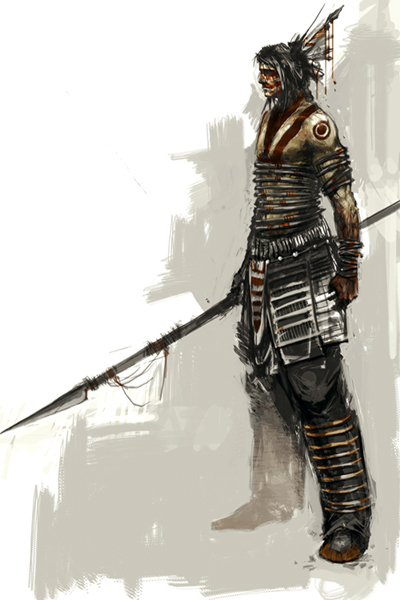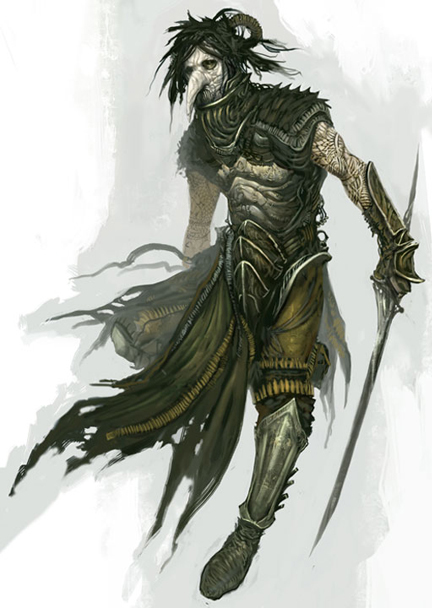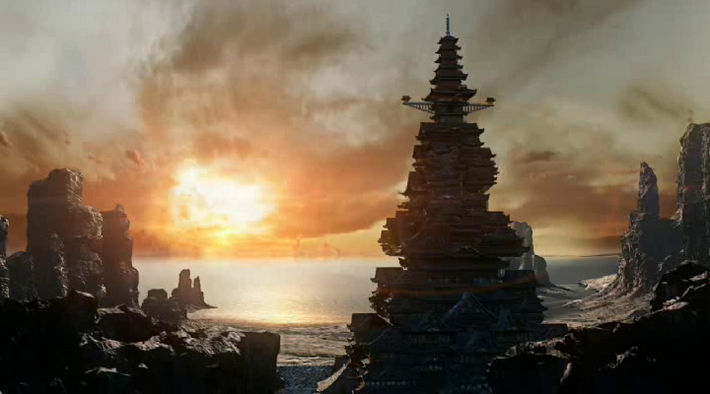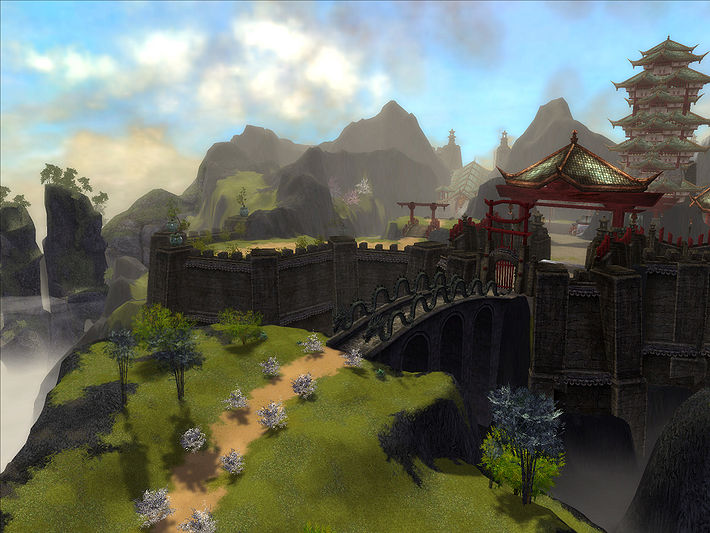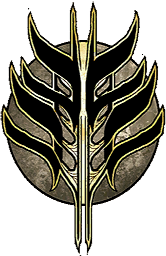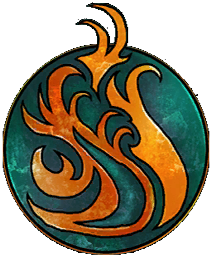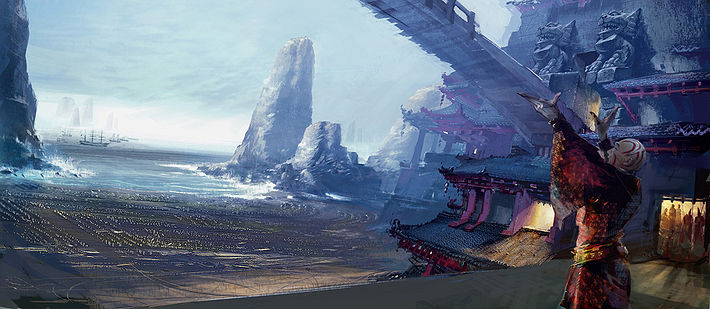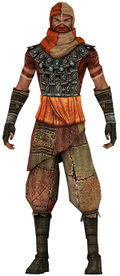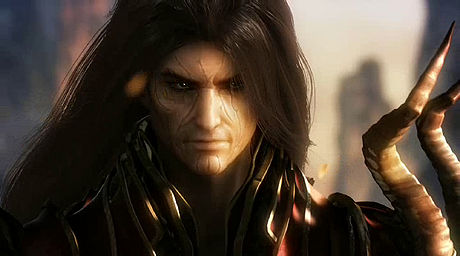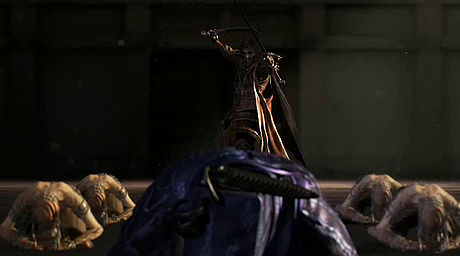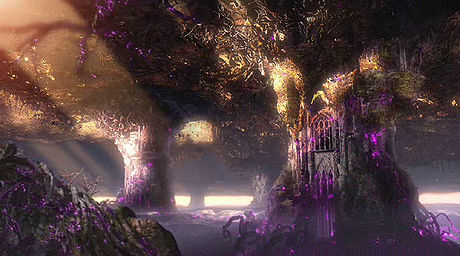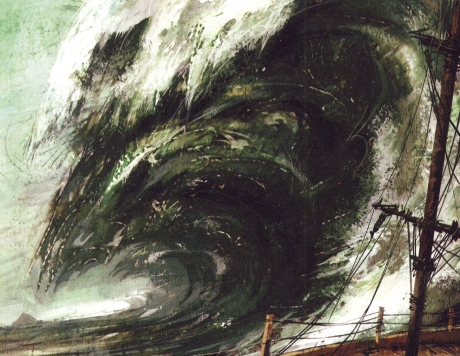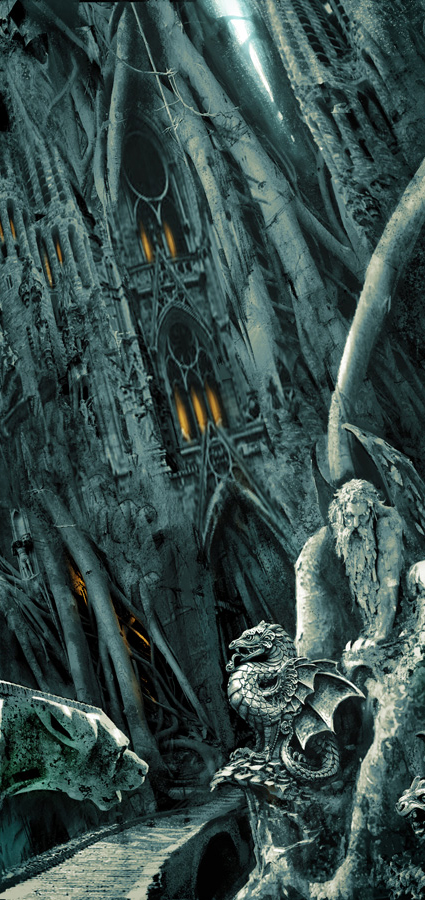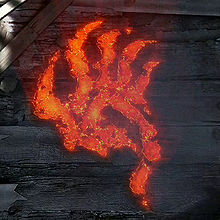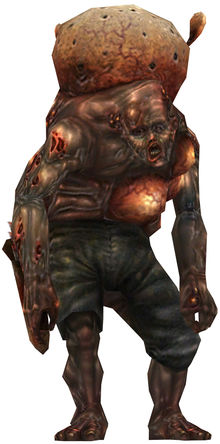An Empire Divided
| This article is, or is derived from, the property of ArenaNet or NCSoft and used with permission. The terms of the permission do not include third party use. It is not released under the GFDL. This article was taken in whole or in part from the Guild Wars Factions: Official Guidebook. Please see Guild Wars Wiki:Copyrights for further information. |
An Empire Divided
A Selected History of Mysterious Cantha for the Traveling Scholar
by Loremaster Ermenred of Ascalon
50th Anniversary Edition
With a New Foreword by the Author
First Printing: 1022 AE
First Printing, 50th Anniversary Edition: 1072 AE
Library of Ascalon No. 1035720-E
Interkingdom License No. 08668
This text is not a work of fiction, but is based on historical fact as interpreted by the author. Historical facts have been revised based upon new information acquired by the author between 1022 AE and 1072 AE.
The Right of Copy within the Kingdom of Ascalon and Parts Beyond is Hereby Reserved by Loremaster Ermenred of Ascalon and the Royal Ascalon Press, All Rights Renewed and Reserved c. 1072 AE.
Cover Illustration by Argwen Grith
ForewordWhat a difference an ocean can make. Though only a few hundred miles away from Tyria, the people of Cantha have evolved a way of life that is in some ways alien to our own and in other ways comfortably familiar. And despite more than a thousand years of trade between the Tyrian and Canthan cultures, few Tyrians have set foot on the majestic southern continent for almost two hundred years. It took almost a decade of effort and a great deal of my own personal fortune to arrange my year-long study of the Dragon Empire in the year 1022 AE, but it was time (and gold) well spent. During that year, I was able to open new routes for merchants and uncover new mysteries of the nations of Cantha. Also, all modesty aside, I established strong cultural ties with Canthan academics and the emperor himself. In the decades since my epic journey through Cantha, those cultural ties have remained vibrant. An exchange program between the Kingdom of Ascalon and the masters of Shing Jea has resulted in a greater understanding of political, military and magical issues. I myself had not returned to see old friends and colleagues for many years, but when the opportunity arose to travel along what has become known as the "Ermenred Trail" as a royal ambassador for King Adelbern, I jumped at the opportunity. What I found was surprising. Contrary to reports of a prosperous empire, I discovered this impression was one carefully cultivated by the proud Canthan people and the agents of Xunlai. While much of Cantha is prosperous, the disparity between the wealthy nobility and the more desperate elements of society has grown. The sprawling Canthan capital of Kaineng City now covers almost a sixth of the main continent, and grows more densely populated by the day. Street gangs, once merely bands of loosely affiliated criminals, have organized and become more powerful on the streets of Kaineng, even as corruption grows in the bureaucratic Celestial Ministry. The seeds of the empire's current troubles were planted long ago, brought to bloom by Shiro Tagachi's murderous acts two hundred years earlier, but it took much longer for the trouble to bear real fruit. Now, almost fifty years since I first visited the empire, a great deal has changed; and much of it has not been to the betterment of the Kurzick |
and Luxon nations (the so-called "vassal states" that make up more than half of the empire's geographic area). The impact of the Jade Wind—the disastrous event that transformed so much of the Canthan continent to stone and crystal nearly two centuries earlier—appears to be growing more dire each year, a process which seems to have accelerated since my first visit. The Kurzicks and Luxons, always hostile to one another, have grown even more combative as valuable resources have become scarce. The Canthan Emperor Kisu, the nominal ruler of the entire continent as well as massive Shing Jea Island, has been unable to rein in the nationalist tendencies of either faction. Kisu has his hands full with the political and economic necessities of running a kingdom—one which had to move its agricultural center over a short period of time—while simultaneously coping with the perils of overpopulation in the capital. The Kurzicks of Echovald Forest and the Luxons of the now literally named Jade Sea have regained a great deal of their former independence, in fact, whatever their "ruler" in Cantha may say. Unfortunately for all, the two nations have chosen to turn this independence toward increasingly heated conflicts. Unable to farm for themselves in forests turned to stone or to fish in seas that have become jade, they instead compete for the jade itself and the rare mineral found within it. This jade then provides for the needs of their people, in theory. In practice, it appears that the corruption endemic to the bureaucracy has spread, resulting in more destructive mining practices, and more border skirmishes than ever. Perhaps most troubling of all are the scattered reports of new, smaller factions springing up in unexpected places. A piratical cult known as the Crimson Skull plagues the wilder areas of Shing Jea Island, the precious jewel of the dragon crown. As I gathered data and lore from my renewed contacts within the academic class of Cantha, I learned of many dark and forbidding omens appearing with greater consistency over the last few decades. Unfortunately for the Empire of the Dragon, these omens could not come at a worse time. If there is any good fortune in the situation, it is that the Angchu Tengu remain on friendly terms with the Canthan government. These noble creatures have long honored the peace between the elders of their capital village |
and the emperor. Many suspected that the Angchu of Aerie would turn violent as the empire's troubles grew. But a relatively small population, coupled with the fact that their home was more or less untouched by the Jade Wind, has meant continued peace with the humans, albeit with a new veneer of caution bordering on distrust. The Angchu Tengu, unlike their Sensali cousins, are aware that not all humans are their enemies, and have made the wise choice in this scholar's opinion. The tome you hold in your hands has been revised and updated based upon this most recent visit, and could not have been possible without the assistance of the venerable Master Togo of Shing Jea Monastery, my colleague in academia and one of the most respected figures in Canthan society. It is my hope that this special fiftieth anniversary edition of An Empire Divided will stir renewed interest and, yes, concern for Tyria's southern neighbors. A stable and peaceful Cantha is in the interest not just of Emperor Kisu, but of all human kingdoms, wherever they may be. —Loremaster Ermenred |
Ancient HistoryThe Imperial LineThe emperors of Cantha represent the longest unbroken line of ancestral succession seen in the world. The first emperor, Kaineng Tah (after whom the capital, Kaineng City, is named) was said to have fathered over two hundred sons and daughters both with his wife and thirty favored concubines. This means that although the throne has not always passed directly from father to son, it has always gone to one of royal blood—at most, a first cousin (as seen in several well-documented cases). Though it is hardly egalitarian from an Ascalon point of view, the empire has always been ruled by the previous emperor's nearest male relation. The title of "empress" is bestowed only through marriage and has little real power in the patriarchal Canthan society. The current emperor (the 31st in the line) is Kisu, the son of the previous emperor, Kintah. Noted Emperors of CanthaThough the bloodline of the Canthan emperors has remained more or less unbroken for more than a millennium, the specific prefix attached to the word "emperor" changed significantly in the year 1 AE (510 by Canthan reckoning). In the Canthan tongue, the title went from Kaineng Chang, literally "emperor lord," to "Kaineng Weh no Su," or "Emperor Near to the Stars." In the common tongue spoken in Tyria and modern Cantha, this is usually translated as "Ascendant Emperor." This is attributed to the fact that young princes of royal blood are expected to train in one or more of the heroic professions and ascend to a higher plane of awareness, a tradition begun with Chang Hai, a prince, Warrior, |
and Monk who became the first such ruler of the empire. Kaineng Tah1st lord emperor of Cantha; founded Kaineng City. Chang Hai1st Ascendant Emperor, 11th actual emperor; a Warrior Monk whose exploits still provide popular reading for historians and the masses alike. Singtah23rd emperor; a cruel man who died in the fire which consumed the first Raisu Palace. Senvho24th emperor; ordered the 80-year reconstruction of Raisu Palace and is said to have breathed his last after taking his place on the new throne. Angsiyan26th emperor; murdered by Shiro Tagachi. Hanjai27th emperor; was instrumental in preventing the empire from falling into chaos following the devastation of the Jade Wind. Kintah30th emperor; reopened trade and diplomacy between Cantha and the Tyrian kingdoms. Kisu31st emperor and current sovereign of Cantha; by all accounts a wise and benevolent ruler, though he is considerably more withdrawn than his father, who was known as a man of the people.
Unique Canthan ProfessionsThe heroes of Cantha choose from eight primary disciplines. The traditional Warrior, Elementalist, Monk, Ranger, Mesmer, or Necromancer (filtered through |
a Canthan sensibility) can be found to the south, along with two more that are unique to Cantha. The Assassin and Ritualist disciplines both have deep roots in Cantha's ancient past.
The Assassin: A Noble KillerThe Assassin profession was a natural outgrowth of a culture divided between nobility and the common folk for as long as any in Cantha can remember. Assassins originally filled a simple need for Canthan nobles—the ability to quickly eliminate a single rival or enemy, with a minimum of fuss or bother on the part of said nobles. Assassins were and are hired or (more often) kept on retainer for this very purpose even today. As the ranks of the nobility grew, more Assassins were required to keep up with demand, and soon they began to organize into their own unions and guilds to ensure fair payment for the Assassin and to establish rules and regulations that govern the profession's work. Eventually these organizations became self-perpetuating, and now few Assassins work for only one client. Those who have—including, according to the histories, the Betrayer called Shiro Tagachi—are usually employed as bodyguards to the most powerful Canthans.
The Ritualist: Spiritual TraditionMore than a thousand years ago, it is said, the gods of Tyria left this world behind—but not before granting the power of magic to the humans who lived there. Although Cantha was settled by humans hundreds of years before the northern continent, Canthan humans did not possess magical power as we currently understand it. Indeed, true magic seems to have appeared in Cantha at the same time it emerged in Tyria. Before this time, however, the Ritualist tradition was already long established. |
|
According to historians, these early Ritualists from the pre-magic era relied on a similar power granted by the dead—by ancestors of the great and powerful who maintained a connection to their descendents. The power of Spirit allowed mortal humans to practice what might be seen as a form of magic. These human Ritualists adapted to true magic when the gods introduced it, but still rely on the Spirits of the dead to put these skills into practice. Unfortunately for scholars such
|
as myself, the skills of the true Ritualist are no longer to be seen; but those that evolved from the merging of magic and Spirit certainly are widespread. Master Togo of Shing Jea Monastery, to name just one example, is a Ritualist of uncanny ability. On the Canthan CalendarCanthans reckon the years with a lunar calendar that was old when the Kingdom of Ascalon was still a loose confederation of |
primitive tribes. The Canthan year 0 is the same as the Mouvelian (i.e., Tyrian) year 510 BE; the Mouvelian year 0 is the year 510 to Canthans. Before the Canthan year 0, a variety of lunar calendars were used all over the continent—it is no coincidence that the year 0 coincides with the ascension of the first lord emperor, since he ordered the unification of all such calendars upon taking the throne. Astrologers break Cantha's history into "ages" named after important constellations. At the time of this writing, Cantha is in the third century of the Age of the Dragon. When this age will end, only the astrologers can say. And the cynic might opine that the preservation and protection of such knowledge is one of the ways the astrologers keep their jobs.
Major EventsLate Pre-Imperial EraEven in Tyria, we humans have forgotten where we came from...literally. All that is known of the origin of the Tyrian human race is that our species appeared more than 1,200 years ago on the northern continent. Humans settled Cantha even earlier, however, and appear to have done so on multiple occasions during what Canthans call the Late Pre-Imperial Era. Even less is known about the origin of the Luxon and Kurzick peoples, who arrived on the continent after the tribes that would become modern Canthans settled the northwest coast and Shing Jea Island. The humans of Cantha may have actually originated on Shing Jea, though this has never been proven. Surprisingly, although surviving records and artifacts from this period prove that the serpentine Forgotten dwelt in Cantha as well, they appear not to have come into conflict with humans there. My own interpretation of the data indicates that geographic reasons are most likely: the two races did not compete for food or territory before the Forgotten departed the world en masse. |
|
What is also clear, and requires no interpretation on my part, is that the Canthan people rapidly advanced and unified, while the Kurzicks and Luxons, whatever their origins, did not become true nations until much later. This left the Canthans in the dominant political and military position, which they would hold for the rest of the continent's history.
0 CC (Age of the Marmoset) (510 BE)The confederation of tribes that called
|
themselves Canthans united in the year 0 by Canthan reckoning—yes, before humans had even left their mark in Tyria, perhaps even before humans existed in Tyria, the Canthans forged an empire. This empire did not arise on its own, of course. It took a mighty warlord by the name of Kaing to bring the clans together under his bloody banner, most likely to defend against the growing Kurzick and Luxon populations, though this is one case where Canthan historical records may not be entirely trustworthy. (According to these records, the gods themselves ordered Kaineng to unite the clans.) Whatever the |
reason, the warlord Kaing took the name Kaineng Tah when he declared himself the first lord emperor of the dragon. This seminal event marked the dawn of the astrological Age of the Marmoset, a creature revered in Canthan culture for its cleverness, fortitude, and nobility. The new emperor needed a palace, a place to show other mortals his magnificence. A place that even the gods would respect and find worthy. And so, in this year, construction also began on the first Raisu Palace. It would not be finished until after Kaineng Tah's death.
46 CC (464 BE)Forty-six years and several months after he brought the clans together to form an empire, Lord Emperor Kaineng Tah left the mortal realm for good under what were clearly, to the eye of an outsider, suspicious circumstances. Though he was in his seventies, by all contemporary accounts the lord emperor was in excellent health. His death came from an unlikely event: while on an extended hunting expedition, his favorite horse improbably threw Kaineng Tah. It is doubtful that the faithful, well-trained beast would have done this out of belligerence, though Canthan history does classify the death as completely accidental. It seems more likely that one or more of the emperor's fellow huntsmen spooked the horse. Fragmentary records of an unexplained wound on the horse's rump and three more such wounds on Kaineng Tah himself would appear to support this interpretation. Whatever the cause, Kaineng Tah's death left a void at the top that needed to be filled if Cantha was to continue on the path of empire. Since the lord emperor left no will behind (at least, none survived—it is possible the will was destroyed, as contemporary writings by Kaineng Tah indicate the document existed at some point) the throne passed directly to the older of his two sons, Yian Zho. This |
|
demonstrates the ironclad patriarchal structure of Canthan society that pervades the upper echelons of nobility to this day, as Yian Zho's two elder sisters were neither consulted nor welcome in the succeeding government. Their fates are unknown, but they vanish from the record weeks after Yian Zho took the mantle of emperor.
48 CC (462 BE)After decades of unsuccessful conflict, the Luxon tribes themselves united into a true nation only two years after Kaineng Tah's death. According to their legends, this was due to renewed aggression from the Canthans. Under Kaineng Tah the empire had reached peaceful pacts with both of the less-developed cultures with which Cantha shared a continent, making the Kurzick and Luxon people subjects of the emperor. When Yian Zho began a bloody campaign to quell what he called an insurgency in the Luxon territories and slaughtered hundreds of Luxon elders in grand public executions, the tribes finally decided enough was enough. They formally declared themselves to be the Luxon nation and attempted to secede from the Empire of the Dragon. Though true secession proved impossible for the Luxons to win, they did eventually gain a new status as a vassal state—independent to a point, but still technically part of the empire. It is believed that this, perhaps more than any other reason, is why the Luxons turned their ire on their Kurzick neighbors in the Echovald Forest. That rivalry has never subsided, and even today the borders between the two are marked with frequent skirmishes and bloodshed. 51 CC (459 BE)Like the Luxons before them, the Kurzicks were likely driven to unity by the belligerence of the new emperor. Yian Zho was his father's son when it came |
to strategy, intelligence, horsemanship, and progeny (like Kaineng Tah, Yian Zho had several dozen children by his many concubines—children who carried the blood of the emperor, but no claim to the throne according to Canthan mores and values). His temper, however, was legendarily short, and he brutally put down a relatively small Kurzick uprising early in this year. This, coupled with the new threat of a unified Luxon state in the sea to the east, led directly to Kurzick unity. Belligerent and brutal though he may have been, even Lord Emperor Yian Zho was unable to drive the Kurzicks from the Echovald—they knew the forest far too well. He was able to contain them within those loose borders, however, and soon was convinced by sage advisors to arrive at much the same arrangement that had been forged with the Luxons. The Kurzicks, too, became a vassal state. Unlike their neighbors, they remained much more isolated, which in my interpretation is a driving force behind the intense competition between Kurzick Houses for domination within their own unique political structure. 305 CC (Age of the Falcon) (205 BE)Though the news would not arrive in the Empire of the Dragon for several decades after the fact, the year 305 by Canthan reckoning saw the arrival of humans on the continent of Tyria. When news of these primitive barbarians did eventually reach Cantha, it was considered of little consequence. Perhaps, if the Canthans had seen fit to drive north and expand their empire, history would have played out very differently. But with the concerns and needs of an already sprawling realm, the emperors of Cantha chose to remain within their borders. And so the various Tyrian cultures developed, unhindered by—and for the most part, unaware of—their southern neighbors. |
509 CC (1 BE)The gods of Tyria are known to have walked the land relatively recently, and not just on the northern continent. The same gods also visited Cantha, and were worshipped there alongside the spirits of Cantha's ancestors. But it was not until the Canthan year 509 that the gods granted humans—to the north, south, and parts beyond—the gift of true magic. Before this spectacular event, what Canthans called "magic" was actually power granted by their ancestor Spirits, a practice which continues to this day with the Ritualists. The gift of magic altered the practices of Ritualists very little; if anything it only made their abilities more powerful than before.
510 CC (Year 0)Only a year after giving magic to humanity, the gods—for reasons that are not yet completely understood—left the mortal realm for good. They did not abandon humans to their fates, however. Monks maintained a spiritual link to the gods; Balthazar, Lyssa, Dwayna, Melandru and Grenth continue to hear prayers and grant blessings to those mortals who seek them out. But the days when god and man spoke face to face were over. Many have hypothesized that the lack of historical data concerning this supernatural event is the work of the gods themselves, who do not wish humans to know where they went, or why. At the risk of blasphemy, I support this assertion. The gods certainly must have had their reasons, but whatever those reasons, they did not share them with humans. Not even the much more complete and detailed histories of Cantha can say for certain why the gods departed...only that they did. |
511 CC (Age of the Bat) (1 AE)The departure of the gods and the almost simultaneous gift of magic had a profound effect on all human cultures, especially those in Cantha. The heroic professions—their formal practices and requirements still in infancy—became widespread. The eldest prince of the imperial line, Chanang, defied the wishes of his father and chose to follow the hero's path. He studied the ways of the Warrior and spent four years at a remote temple on the island of Shing Jea learning the holy practices of the Monk. Then he set out to perform great deeds as a true hero of Cantha. Thanks to a small coterie of scribes that traveled with him, his exploits are still widely read in Cantha a thousand years later. Chanang became one of the first Canthan heroes to become Closer to the Stars (what in Tyria is referred to as "ascension") and, when the time came to succeed his father on the throne, he refused the title "lord emperor" and instead became the first "ascendant emperor," changing his name to Chang Hai. Since then, all emperors have been required—by family tradition if not actual law—to practice in at least two of the heroic professions. Today, Kisu is the 31st Canthan emperor, but is also the 20th ascendant emperor.
731 CC (Age of the Hedgehog) (221 AE)The Empire of the Dragon had been a unified power for centuries when the kingdoms of Tyria finally made contact. The first ships to arrive on the southern continent found a culture much more advanced than their own, and in a display of wisdom that likely prevented Tyria's first intercontinental war, chose to make peace as soon as possible. This opened up lines of shipping and trade with Cantha that benefited both the venerable southern society and the relatively young kingdoms to the north—Tyrians received knowledge |
and technology, while Cantha received badly needed natural resources. Shing Jea Island, heavily logged for centuries, began the long road to recovery in this year, resulting in the pastoral agricultural land (Cantha's breadbasket) seen today.
1204 CC (Age of the Tortoise) (694 AE)Many emperors in Canthan history have met with unnatural deaths—assassination is a Canthan tradition, of course—but none so spectacularly as Emperor Singtah. This unpopular and infamously cruel ruler was known for carrying out mass public executions of his political enemies and for heavy taxation of the peasant class. When he ordered the elimination of an entire town that had, he said, refused to pay proper fealty to their emperor, the peasants decided they had had enough. Though the histories do not say exactly how, rebels appear to have infiltrated Raisu Palace (perhaps with the help of traitorous soldiers, who were also ill-treated by Singtah) and burned it to the ground. The emperor's son, Senvho, ascended to the throne soon after, but did not enact widely expected revenge on the peasants who burned his father alive. Instead, Senvho displayed uncanny wisdom by decrying Singtah's most egregious abuses of power. After this noble beginning, however, Senvho became obsessed with rebuilding Raisu Palace. It took over eighty years to finish construction on the elaborate new structure, but once completed, it was considered the one great achievement of Emperor Senvho's reign. It would fall to Senvho's successor to begin making right the inequities of Canthan society, an effort that would ultimately (in this scholar's view) fail. |
1382 CC (Age of the Dragon) (872 AE)The year 1382—872 by Tyrian reckoning—began auspiciously. Through continued diplomatic efforts and wise policy decisions, Emperor Angsiyan signed new treaties of cooperation with the Kurzicks and Luxons, bringing them further into the imperial fold than they had been for hundreds of years. This cooperation extended so far that the Kurzicks and Luxons declared peace with each other, and their champions joined the emperor on his visit to the Harvest Temple for that year's Harvest Festival as honored guests. But this brief peace—enthusiastically dubbed the Age of the Dragon by joyous astrologers—was not to last. The emperor's bodyguard, a talented young Assassin named Shiro Tagachi who could trace his family line back to Kaineng Tah's concubines, betrayed Emperor Angsiyan as the ruler gave thanks to the gods for another bountiful year. Tagachi might have succeeded in taking the throne for himself—if that was indeed his purpose—if not for the champions of the Kurzick and Luxon nations. These two heroes charged to the emperor's defense, and though they arrived too late to save Angsiyan, they somehow succeeded in striking Shiro Tagachi down. What happened next is understandably sketchy at best. What is known for certain is that Shiro was slain while performing a dark ritual that would have granted him great power. When he died, his soul unleashed this power with extraordinary force. This death wail became a shockwave, killing thousands in the immediate epicenter and washing over the Canthan continent like a typhoon. Everything the wave touched turned to stone. The Echovald Forest became utterly petrified. The Jade Sea's name became distressingly literal as the waves crystallized and were transformed. Anything living that was caught in the direct path of this "Jade Wind" suffered the same fate, leaving behind grisly relics |
|
that appear to be fine sculptures (and have indeed been sold as such by unscrupulous merchants) but are in fact the 200-year-old bodies of the dead. Although the Kurzicks and Luxons almost immediately took advantage of their champions' mysterious deaths to resume their ages-old state of conflict, the imperial bloodline once again survived in the form of Hanjai, who at 17 was the youngest emperor in Canthan history to take the throne. He faced a realm in turmoil, but was able to begin the processes that would allow the Empire of the Dragon to go on, even with more than half the continent utterly transformed by the Jade Wind. He oversaw the move of hundreds of farmers to the island of Shing Jea, and opened the gates of the capital, Kaineng City, to any who wished to move there permanently. This would eventually lead to infamous overcrowding and poverty in the sprawling capital, but at the time was the only way to keep the Canthan population from getting caught up in renewed violence between the vassal states. Yes, the empire would go on, but at a great price. Relations with the kingdoms of Tyria began to fall into disrepair as diplomats were recalled to replace those killed in the Jade Wind event, and lines of trade were cut off by increasingly bold pirates (these pirates would later unite to become the Crimson Skull plaguing the shores of Shing Jea to this day). Cantha became more isolated than ever from the world.
1390 CC (880 AE)The savage bird-men known as Tengu had long kept to their own mountainous territory in the more remote areas of verdant Shing Jea Island. The Tengu population was stable and small, and their behavior was relatively peaceful, so the Canthans had never seen any reason to make war on them (and vice versa). As more Canthans settled Shing Jea, however, |
the newcomers spread rapidly over land that the two largest Tengu tribes had always assumed was their domain. What began as a few skirmishes soon threatened to become outright war, especially after Warriors of the Sensali Tengu tribe massacred an entire village of Canthan farmers, burned their farmhouses to the ground, and (according to contemporary reports) consumed the bodies of the dead. Only through the efforts of Emperor Hanjai's personal ambassador and a wise, |
levelheaded Angchu Tengu chieftain was open war averted. The Angchu signed a formal peace agreement with the Canthan ambassador declaring the mountain village of Aerie to be Angchu Territory for as long as the sun shone in the sky. The Sensali were incensed that the Angchu chose to speak for all Tengu (even though the Angchu never claimed to have done so). They declared Aerie to be a town of traitors, while their hatred of the Canthans |
|
only burned hotter than ever. The Sensali retreated to the rocky peaks that could never be used for agriculture, launching occasional raids into the lowlands. The Angchu, on the other hand, have honored their agreements with the Canthans (the Canthans, for their part, have done the same) but the Sensali have never forgiven either of them. They remain a dire threat to unwary travelers looking to take a shortcut through the mountains of Shing Jea.
1412 CC (902 AE)Hanjai's successor was considered by many to be a petty, small-minded man ill-suited to ruling the Empire of the Dragon. |
It was he who formally dissolved the longstanding trade agreements with the northern kingdoms and declared that the Kurzicks and Luxons could, for all he cared, "wipe each other off the map." His reign marked the beginning of the most isolationist period in Canthan history; it would not be until a scholar named Ermenred (if I may be so bold) toured the realm that formal trade and diplomatic channels would be reopened between the continents.
1450 CC (940 AE)The Canthan embassy in Ascalon City had stood empty for nearly forty years |
when it was formally closed by decree of Ascalon's king. This event went virtually unnoticed by the Canthan empire, as they had already cut off contact with their neighbors to the north. The structure was converted to a temple which was subsequently destroyed by an earthquake blamed by many on disapproving gods.
1527 CC (1017 AE)As the Guild Wars raged across the northern continent, Cantha also saw an increase in open warfare (although they were not drawn into the greater conflict in Tyria). The Luxons and Kurzicks proclaimed open hostilities once and for all, exchanging a long period of undeclared warfare for the real thing. The difference was lost on the rest of Cantha, which was still primarily concerned with its own survival.
1532 CC (1022 AE)During this year, I, Ermenred of Ascalon, made my first contact with the empire. Through careful negotiation, I was invited by noble Emperor Kintah—father of the current emperor, Kisu—to visit and tour the continent and Shing Jea Island in hopes of resuming trade and diplomacy between the north and south. I do not flatter myself when I write that the journey was remarkably successful. Informal lines of trade reopened, and cultural exchanges began in earnest as young Ascalons set out to learn for themselves about the mysterious land of Cantha. The rest of this book consists of a revised and updated account of this journey, as well as the one I made fifty years later. 1568 CC (1058 AE)A great and visionary man that I called friend, the Emperor Kintah, finally died of old age at the dawn of a new era. His son Kisu proved an able and involved leader who continued his father's diplomatic efforts to establish trade agreements between Cantha and the kingdoms of |
|
Tyria. He was aided by the renowned head of Shing Jea Monastery, the noble Master Togo, who often served as Kisu's personal ambassador during this period. It would fall to Kisu to draw up new treaties with the Kurzicks and Luxons, forcing them to cease their open warfare and resume the border skirmishes which had been their lot for hundreds of years—not a perfect solution, but the best (in my own opinion) that could be hoped at the time. This was also the year that the Xunlai guild of Cantha extended its services to the northern kingdoms, where they are a common sight to this day. 1581 CC (1071 AE)Following the end of the Tyrian Guild Wars, relations between the kingdom of Ascalon and the Empire of the Dragon were at last formalized. As one intimately involved in this agreement, I can write that while it was indeed welcome, it merely established on parchment the trade status which had in truth been strong for decades. Still, one of my most treasured memories is the signing of the Second Treaty of Lion's Arch.
|
1582 CC (1072 AE)And so we reach the present day. At the time of this writing, the kingdom of Ascalon is recovering from the conflict with the Charr and is establishing new treaties with the Krytans and Elonians. To the south—and I write from personal experience, as this very moment I am in the Great Library of Shing Jea Monastery—things are not so rosy. Despite renewed trade between the continents, the capital of Cantha is more overcrowded than ever. Violent, well-organized street gangs hold sway over the older, poorer sections of Kaineng City. A wild population of bizarre, insectoid creatures have seen a population boom both on the main continent and on Shing Jea Island. The piratical Crimson Skull cultists continue to plague the shipping lanes and demand tribute from remote farmlands, and the cold war between Kurzick and Luxon appears to be heating up once more. And there is something else. Something darker. My colleague Master Togo is troubled by reports of a strange plague afflicting the creatures of the Shing Jea countryside, a plague that causes freakish |
mutations and transforms most anything it touches into hideous, savage monsters. Should this so-called Affliction spread to humans the result could be catastrophic—not just for Cantha, but for the entire world. Soon I must depart for my home in Ascalon, but it is with a hopeful spirit that Master Togo has told me he expects help to arrive soon in the form of a young hero who was instrumental in dealing with the Flameseeker Prophecies. I wish Mhenlo and Togo the best of luck, but this new challenge is not one for the old. Perhaps someday I will return to Cantha, but for now, I must bid farewell to the Empire of the Dragon. May the gods see these noble people through the dark times to come, and may the heroes of Cantha meet these challenges with courage and honor. |
Cantha TodayThe continent of Cantha is a constantly evolving empire where many different societies and cultures live in relative harmony while others are frequently in a state of open conflict. Dangers can be found in areas where no law holds sway, and there are many such places in Cantha. Creatures of nightmarish origin stalk the darker corners of the continent, and there are lonely highways where hellish fiends feast on unwary victims who take the wrong road after sunset. Beings that once existed to protect all life now exist only to destroy those who turned their world to cold, lifeless stone. And amidst it all, the Kurzicks and Luxons continue their centuries-long war, with no end in sight. |
The Kurzick FactionThe Kurzicks are a devout people who take worship of the five gods very seriously. They are divided by blood into five great houses, each of which is devoted to a different deity and their own cultural obsessions. The leaders of the great houses do not always get along, but like all Kurzicks they share a deep-seated hatred of the Luxons, their enemies since long before Shiro Tagachi was born. Historians doubt the Kurzick nation originated on the Canthan continent, but to this day, even they do not remember whence they came to dwell in the Echovald Forest. The Kurzicks have lost much of their ancient history to the past, and now the stone trees are their only home. Just as the Luxons mine precious veins of magic-suffused jade from the petrified seas, the Kurzicks mine amber from the forest, precious life in solid form |
that grants great power to those who know how to manipulate it. House zu HeltzerIf one house rules the others, it is House zu Heltzer. They are justifiably proud to call Saint Viktor an ancestor of their line, and Count zu Heltzer is not above lording this fact over the other houses at times. House zu Heltzer also deserves much of the credit for their people's current cultural renaissance of philosophy, magic, |
|
medicine, and art. They are renowned for their magical innovations, their lifesaving techniques, and their practical methods of enchanting and shaping the stone that makes up the Kurzick domain. They are also well-versed in the arts of magical wards and protection. If there is one thing they are better at shaping than stone, it is political thought, as their continued leadership role in the faction attests. Their patron god is Dwayna. House VasburgThe second most politically powerful of the great Kurzick houses, House Vasburg are the greatest warriors of the Kurzick nation. To the Vasburgs, violence is a beautiful dance, an expression of life and death that cannot be equaled by any other experience. Most train their whole lives with the expectation that those lives may end at any moment, and enter the fray with a bloodlust bordering on religious exultation. House Vasburg has lost more fighters in the war with the Luxons than any other house, a fact of which they are quite proud. Their patron god is Balthazar. House BrauerHouse Brauer leads the infinite pursuit of the aesthetic among the Kurzicks. Brauers are responsible for the finest sculptures and most awe-inspiring paintings the people of the Echovald have ever produced, and they consider it their house's mission to bring color and life into their cold, petrified homeland. They are not above experimentation with untried methods of artistic expression, and some experiments are much more successful than others. Of all the houses, they are the least suited to warfare, but when duty calls they will not fail to answer. Their patron god is Lyssa. House LutgardisThe Lutgardis are devoted to the study and creation of music in all its myriad forms. They are masters of performance and create the finest musical instruments |
in all of Cantha—for hundreds of years, in fact, no emperor of Cantha has ascended to the throne without the inspirational orchestration of Lutgardis instruments, usually played by the Lutgardis themslves. They use music to cleanse the streams and bring what new life they can to the forest. They are the house of the tree singers—Kurzicks with a special bond to the few living trees left in the Echovald—and they protect them with their song and with their lives. To the Lutgardis, there is little difference between the two. Their patron god is Melandru. House DurheimKnown by many nicknames, the most common of which is "the old house," the Kurzicks of House Durheim maintain the histories of their own culture, and much of the rest of Cantha. They have a deep reverence for their past, and study genealogy with a passion; this devotion to the dead, they claim, has given them a special bond with Grenth. According to the Durheim, Grenth has rewarded this dedication to him by granting them the magical ability to chronicle the life of every Kurzick ever born. Curiously, those not devoted to the study of history are most likely to be poets and playwrights—or perhaps that is not curious at all, as both pursuits glorify the nobility of death in all its forms, especially in Kurzick society. Their patron god, of course, is Grenth. The Luxon FactionThe Kurzicks are known to be the disciplined, organized faction in the ongoing conflict. The Luxons may not follow or even know all the laws of Cantha, but they do know that neither the laws of humans nor gods will feed their nomadic clans. They are not as concerned with the opinions of the gods as are the Kurzicks, but most pray regularly to Balthazar, Grenth, or (to the surprise of those who have never seen the intrinsic beauty of Luxon architecture and engineering) Lyssa. Luxon children still hear stories of their people's original home, a nameless |
place far across the open ocean and lost now to the land-bound faction, seemingly forever. Some historians believe that new discoveries point to a Luxon presence in the Crystal Desert more than a thousand years ago, but just as many believe this to be a misinterpretation of the evidence. The Jade Wind transformed more than just the Luxons' home. It transformed their very way of life—a life of sailing, trading, and nomadic, traveling communities. Luxons always respected strength more than any other virtue, but now that the sea was no longer a sea, strength became even more important for the survival of the clans. Strength, defined in any and every way, is what the Luxons now revere, perhaps even more than some of the gods. Though there may once have been more, three dominant clans—sometimes called "armadas," a holdover from their true seafaring days—share collective rule of the Luxon faction. The leaders of the clans are named captain upon fighting their way to the top. For the first time in their history (an admittedly spotty record) all three captains are women. They each carry the formal title of captain, but are often collectively referred to as the Three Queens. The Turtle ClanThough the Luxon clans tend to get along even more poorly than the Kurzick houses, they too are united by hatred of the other faction. The Turtle Clan is the most prominent and well-known of the Luxon armadas, possessed of the fiercest warriors and most destructive magic in the |
|
Jade Sea. They also control and breed the mammoth siege turtles, living weapons of terrible power that must still be raised from hatchlings, a long and difficult shepherding process. Unlike the other two clans, they eschew most leviathans, preferring to rely on their trusty siege turtles to get around. The clan champion, Argo, defers to the captain in all political affairs—after all, she is rumored to have come to her position by arranging the death of her father, the previous captain—but many of the Turtle Clan still consider him their true leader. The Crab ClanThe current captain of the wealthy Crab Clan, Queen Amara, was a daughter of the previous captain as well, and was long thought slain by Kurzicks in one of the endless border skirmishes between the two factions. Though her brother wasted little time seizing the leadership post, Amara returned from presumed death leading three saltspray dragons and a rapidly summoned army of loyal |
Crab Warriors. Her brother lost his post in a spectacular battle that left the Jade Sea charred and Amara in charge of the richest clan in the faction. The Crab Clan are the masters of jade mining, and have an uncanny knack for locating the most precious veins of magically concentrated jade within the crystalline sea. Many reavers are also part of this armada, pillaging the remains of vessels and creatures trapped within the Jade Sea. The Crab Clan, appropriately enough, travel in walking leviathans shaped like gigantic crabs. The Serpent ClanThe Serpent Clan are the engineers of the Luxons. They are the ones that first conceived of ways to adapt the faction's mighty sailing vessels into land borne leviathans, and indeed they are often called the Leviathan Clan. These magnificent ships of the land, sometimes moving about on gargantuan legs or sailing over the glassy surface of the Jade Sea on silver runners, come in all sizes. The biggest are large enough to hold three siege turtles, and a favorite tactic on the battlefield is to deploy the |
slow-moving reptiles via leviathan, taking Kurzick soldiers by surprise. Though the Crab are the wealthiest of the armadas, the Serpent Clan is home to the most skilled and successful reavers—specifically when it comes to retrieving treasures from ancient sailing ships believed to be inaccessible by the other clans. Of all three armadas, the Serpent Clan are also the most successful at outright piracy, which Luxons consider an honorable, even necessary, way of life. The Canthan government disagrees, but cannot spare the resources to combat the armada's depredations, especially since the pirates are noted for their care with civilian passengers. As long as the Serpent Clan do not engage in wholesale slaughter of Canthan citizens on the open seas of jade, the ministries of government are more than happy to look the other way. Their current captain, Lexis, dueled her way into her position, but her skill at piracy allowed her to keep it. |
The Legacy of Shiro TagachiPerhaps the biggest threat to Cantha is not yet clearly understood by all the denizens of the continent, though some who make it their business to follow such things are deeply troubled. The emperor and his most trusted advisor suspect the worst, and have sent to Tyria for aid. A plague of mysterious origin has been reported in the most remote farmlands of Shing Jea. And someone—perhaps a street gangster aiming to terrify his enemies, or perhaps someone far more sinister—has taken to burning an ancient symbol, a guild emblem not seen for two hundred years, into the stone and earth of Cantha itself. Where this symbol appears, misery and affliction seem to follow. Canthans know the emblem, and know its origin. But few can bring themselves to admit what it must mean: the return of the malevolent killer who triggered the cataclysm that transformed their world. Slain two hundred years ago, Shiro Tagachi turned Cantha to stone when his plans were thwarted in the Harvest Temple. With two centuries to plan his revenge, what might the Destroyer be capable of now? |
The BodyguardA master of the Assassin's disciplines, Shiro was the Emperor Angsiyan's bodyguard, entrusted with his sovereign's life. He famously repelled an attack by Am Fah rebels in 1368, beheading the leader of the ambush and executing even those who surrendered. He proved that a cabal of Canthan ministers conspired to kidnap Angsiyan's young son and heir in 1375. Shiro went on to rescue the child, and in the process eliminated the conspirators and their henchmen as the boy watched. He mounted their heads on pikes outside the Celestial Ministry without orders from the emperor. Though it was never publicly acknowledged by the imperial government, let alone Angsiyan, Shiro deserved much of the credit for bringing the Kurzicks and the Luxons
|
to the negotiating table. The deadly Assassin spoke a language that the warring cultures could understand, and even their champions—the Kurzick Saint Viktor and the Luxon known as Archemorus—stood side by side to pledge their allegiance to the one true emperor. It may have been a stirring in his royal blood—however many generations removed—that initially drove his desire to usurp his cousin and take the imperial throne. But somewhere along the way, dark forces corrupted Shiro Tagachi, forces that he sought out against the laws of his empire and his gods. He learned the ways of forbidden sorcery and engaged in studies and rituals well beyond the disciplines of the Assassin. He found that these taboo powers were second nature to him, and the darkest forms of magic were the easiest of all. No one noticed the hate that burned within him until it was far too late. |
The Day of the Jade WindHowever it began, Shiro consummated his plan on the final day of the Harvest Festival in the year 1382 CC. On that most holy day of the Canthan year, when all of the gods were praised to the heavens and the emperor's divine blessing was placed on the land, Shiro accompanied his sovereign to the Harvest Temple. Though the temple guards objected, he was allowed to retain his blades inside the temple, but the rest of Angsiyan's entourage was not. A sharp-eyed Assassin named Vizu, who had arrived at the festival on the run from Am Fah thugs, took note of Shiro's exchange with the guards. She recognized Shiro, of course; no Assassin in Cantha was unaware that one of their discipline protected the divine ruler of the empire. For the briefest of moments, Shiro's gaze locked with Vizu's, and her heart turned to ice. Behind his eyes she saw the death of the empire. Yet with the emperor surrounded by Ritualist retainers and followed by the champions of the vassal factions and their own retinues, she was unable to act on her premonition—for a time. When the emperor's personal entourage entered the holiest of sanctuaries, the four Ritualists that looked after his immortal soul took their positions at the four points of the compass, and Angsiyan knelt to |
pray. Shiro kept to the shadows near the entrance to the chamber. He struck the moment the emperor had received the second blessing of Holy Dwayna, Shadow Stepping through the void to materialize directly behind Angsiyan's back. With a roar, Shiro drove both of his blades through the emperor's heart. The Ritualists reacted with courage, but they didn't stand a chance. Shiro mercilessly cut them down, though not before the last one to die struck the ceremonial gong that dominated the sanctuary. Outside, the sound of the gong (almost an hour too early) and the lingering, agonized scream of the dying Ritualist alerted the temple guards that there was trouble. The two champions
|
of the vassal factions heard cries that the emperor was in trouble, and did not hesitate. They left their ceremonial positions at the head of their own faction's delegations and charged after the guards to the emperor's side. It would prove to be the last time in recorded history that the two factions worked together willingly. The Assassin Vizu, driven perhaps as much by a wish to evade the Am Fah as she was by the desire of every Canthan to protect and honor her emperor, followed the champions. She too knew the secrets of instantaneous movement, and with a few Shadow Steps she soon found herself in the sanctuary, well ahead of Archemorus, Saint Viktor, and the guards. To her horror, she was alone with two people. One was the emperor, still barely clinging to life, a look of stark agony twisting his features into a terrifying mask. The other was in the process of tearing Angsiyan's soul from his body, consuming it with his raw will, feeding on the emperor's life force as it drained through the conduit of Shiro's enchanted swords. Vizu knew she had to stop the bodyguard, but she could not do it alone. The corpses that littered the room were convincing evidence of that, and the dash up the stairs had sapped her strength. She could |
|
|
only stall for time. Summoning her last reserves of Energy, Vizu called to Shiro, interrupting his efforts momentarily. Then she Shadow Stepped behind him, exactly as Shiro had done to Angsiyan moments before. Unfortunately for Shiro, his pride had not anticipated someone using his own trick against him, and before he could react Vizu drove her daggers into his shoulders. Shiro's swords clattered to the ground, but the bodyguard lashed out a half-second later with a sharp, precise blow that slammed Vizu into the altar and knocked her own weapons from her hands. The delay was enough. Before Shiro could recover his blades and continue to consume the emperor's soul, the champions burst into the sanctuary. Shiro, wounded and dazed from Vizu's sudden attack and the heady infusion of power, stumbled. Archemorus and Saint Viktor—who had both entered the temple unarmed, of course—took the opportunity to take up Shiro's swords. The traitorous sorcerer raised himself to his knees, but the Luxon and the Kurzick met him with his own blades. The champions nearly cut Shiro in half, and for a moment, Vizu believed it was over. Even now, no one but Shiro knows how this act triggered what happened next, or whether it was his plan all along. As the twin swords sliced into his form, Shiro screamed, a sound that rose from the depths of some hellish place and grew to a deafening pitch. The death wail exploded with the palpable force of incalculable power, with the dying Shiro at its epicenter. The champions were the next to die, transformed to stone in an instant. Vizu, her senses returned, witnessed the earliest effects of what became known as the Jade Wind only by using every ounce of Energy she had left. For almost half a minute she stayed one Shadow Step ahead of the screaming shockwave as it petrified the landscape, laying waste to any living thing in its path. She reached the edge of the Jade Sea before her luck and strength |
|
finally gave out, and she died a stony figure on an empty beach. Years later, when Canthan society began to recover, the new emperor's Ritualists would find a way to retrieve the brave Assassin's soul from the netherworld and preserve her essence in a sacred place. But that would not be for some time yet. The Jade Wind continued to expand, radiating out from the Harvest Temple with a shrieking wail that would not dissipate for hours. It consumed the thriving, vibrant life of the Echovald Forest; the holy, ancient trees the Kurzicks called home became stone columns that would never grow again. The waters of the Jade Sea crystallized, waves frozen in eternal crests, ending the seafaring existence of the Luxons in an instant. The farmlands of the continent were mostly spared the effects of the initial wave, but as hordes of terrified survivors swarmed northward to escape, they inadvertently destroyed the entire year's crops. Only by the timely intervention of Angsiyan's heir, who ordered the forced relocation of farmers to Shing Jea Island as one of his first acts as sovereign, did the empire avoid starvation for years to come. In fact, some have gone so far as to say that Shiro targeted the wrong man, so capable was Emperor Hanjai in the aftermath of the disaster. The Destroyer's ReturnToday, as dark times settle over the Empire of the Dragon once more, most historians speculate that Shiro orchestrated the deeds which made him a trusted member of Emperor Angsiyan's court. The Am Fah had ties to the seer said to have told Shiro of his potential destiny. The conspiring ministers happened to have all opposed Shiro's orders at some time or another. Bringing the champions of the Luxons and Kurzicks together to be destroyed simultaneously virtually guaranteed that the two factions would revert to their warlike ways, and perhaps even destroy each other at last, making Shiro the sole power in Cantha. He failed then, but his powers have only grown stronger since his death. Everywhere Shiro's spirit goes, a diseased miasma lingers. This "plague," called by most the Affliction, has no cause the citizens of Cantha can |
fathom, and many mistakenly believe it is a contagion. Little do they know that where Shiro walks, the Afflicted arise. He has also learned how to create terrible constructs—the Shiroken—driven by the captured souls of his most hated enemies, enslaved to his will. No longer bound by flesh and blood, Shiro is now more dangerous than he was in life. Upon his death, the Envoys—the immortal beings tasked by the Oracle of Mists with ferrying souls to the afterlife—called him to join their ranks, and he refused. For two centuries these Envoys, themselves once living beings of great wickedness who serve the Oracle as penance for their mortal crimes, have sought to bring Shiro into the fold. Had he been content to lurk at the fringes of the netherworld, they would have searched as long as the stars shone in the sky. Now that Shiro has made his determination to return to the mortal realm clear, they have decided he must be destroyed. The Envoys cannot do it themselves, but they have foreseen that a hero will come forth with the power to destroy the Destroyer. For Cantha's sake, they had better be right. The AfflictedWherever Shiro walks, the Afflicted appear. The disease, though not contagious, is greatly (and justifiably) feared by the people of Cantha, who have no idea where it comes from or how it spreads. Shiro's frequently appearing guild emblem has led to rumors that have spread more quickly than the Jade Wind itself, many of which are close to the mark. |
Most Afflicted were once clearly human, and those that were heroes in life—for the Affliction does not discriminate—retain their abilities even after the plague has mutated their bodies into unrecognizable monstrosities. The Afflicted are almost always encountered in groups, and are never to be underestimated. The ShirokenShiro's powers of sorcery have grown even stronger since his death, and he long ago learned the secrets of soul transfer. He applied these disciplines to the creation of his Shiroken, a construct army of artificial champions possessed by the enslaved souls of his most hated enemies. Only the destruction of the construct's shell can free the soul within—which is sometimes coherent enough to take on a ghostly form through sheer will. Like the Afflicted, the souls that Shiro enslaves in his constructs retain their magical abilities and professional knowledge, which they will turn against any threat. If he wishes to, Shiro can himself possess the Shiroken, shifting his consciousness from construct to construct with ease. |
| Lore (edit) | |
|---|---|
| Cultures & History | Ecology • Government • Language • Magic • Race • Religion • Species • Timeline |
| Architecture | Architecture of Elona |
| Genealogy | Elonian Royalty • Imperial Dynasty • Tyrian Royalty |
| Storylines | Prophecies • Factions • Nightfall • Eye of the North • Beyond |
| Stories | Chapters: (1) The Wall • (2) The North • (3) The Nolani Academy of the Arcane Arts • (4) The Shiverpeaks • (5) The Dwarves • (6) The Wilds • (7) The Rift • (8) Chasing a Legend The Battle for Kyhlo • The Protectors of Kryta • Sorrow's Furnace |
| Letters | History of Tyria • An Empire Divided • Letters from Kuro • Letters from Neiro • Letters from Togo • War Chronicles • Miku's Tale |
| Lore documents | Canthan Culture • Conflict in Cantha • History of Elona • Nightfall • GW:EN and Now History of the Shining Blade • The Story of the White Mantle • For the Future of Cantha! |
| Cinematics | Core • Prophecies • Factions • Nightfall • Eye of the North • Bonus Mission Pack |
